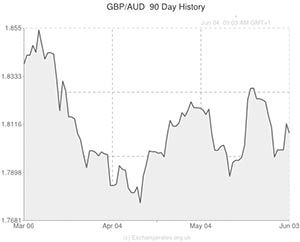
The GBP to AUD exchange rate lost ground on Tuesday as the Australian Dollar recovered earlier losses.
The South Pacific asset had spent much of Monday trending lower as a result of poor domestic building approvals data but was able to stage a rebound after the Reserve Bank of Australia delivered a fairly positive policy statement.
As expected by economists, the RBA left the benchmark cash rate at a record low of 2.5 per cent.
However, Governor Glenn Stevens commented; ‘Growth in the global economy is continuing at a moderate pace, helped by firmer conditions in advanced countries. […] In Australia, the economy grew at a below-trend pace in 2013 overall, but growth looks to have been somewhat firmer around the turn of the year. […] Moderate growth has been occurring in consumer demand and a strong expansion in housing construction is now under way. […] Looking ahead, continued accommodative monetary policy should provide support to demand, and help growth strengthen over time.’
After the RBA delivered its decision the Australian Dollar edged higher against the Pound, US Dollar and Euro.
The ‘Aussie’ held these gains despite domestic retail sales data showing a 0.2 per cent month-on-month increase in April rather than the 0.3 per cent increase anticipated.
China’s non-manufacturing PMI also bolstered the commodity-driven Australian Dollar.
The measure rallied from 54.8 in April to 55.5 in May.
However, China’s HSBC manufacturing PMI was less upbeat, coming in at 49.4 rather than 49.7 as expected.
The Australian Dollar’s advance against the Pound was also limited as the British currency garnered support from the news that UK house prices advanced by a seasonally adjusted 0.7 per cent in May, MoM, more than the 0.6 per cent increase anticipated.
Before the publication of UK construction data the Pound was 0.26 per cent lower against the Australian Dollar.
UK Markit construction PMI came in at 60.0 in May, down from 60.8 in April and short of the 61.0 figure estimated.
However, the result is still one of strong expansion so the Pound is unlikely to be too affected by the news.
As the day progresses influential economic reports from the Eurozone will be of note, as will US factory orders figures.
Investors with an interest in the Pound to Australian Dollar exchange rate will also be focusing on Australia’s AiG performance of service index for May and the nation’s first quarter growth figures.
Australia’s economy is believed to have expanded by 0.9 per cent in the first quarter of the 2014, and have grown 3.2 per cent on the year. This would follow previous readings of 0.8 per cent and 2.8 per cent.
The UK’s composite/services PMI and British Retail Consortium’s shop price index could also impact the Pound to Australian Dollar exchange rate in the middle of the week.
AUD to GBP Update – 04/06/14
The Australian Dollar strengthened against the Pound overnight as Australia’s economy was shown to have grown by more than anticipated in the first quarter of the year.
The better-than-envisaged expansion added to the argument for the Reserve Bank of Australia revising its stance on interest rates and indicated that the economy may be strong enough to withstand the impact of the newly imposed national budget.
In the first quarter of the year the Australian economy expanded by 1.1 per cent on a quarterly basis.
Growth of 0.9 per cent had been estimated.
After the report was released the ‘Aussie’ rallied against rivals like the Pound, US Dollar and Euro.
The news that Australia’s Performance of Services Index climbed to within touching distance of the 50 mark separating growth from contraction also had a positive impact on the South Pacific asset.
The AiG services gauge came in at 49.9 in May following a reading of 48.6 in April.
However, during Australasian trading the advance in the AUD/GBP underwent a little revision as UK services and composite PMI printed at stronger-than-forecast levels.
Although both measures were down slightly from the levels recorded in April, the declines weren’t as severe as expected and showed that the UK economy continues to perform well.
As the day progresses additional currency market movement may follow the release of several influential economic reports for the Eurozone and US.
Investors will also be looking ahead to tomorrow’s Australian trade balance data and China’s composite PMI.
Australian Dollar (AUD) Exchange Rates
[table width=”100%” colwidth=”50|50|50|50|50″ colalign=”left|left|left|left|left”]
Currency, ,Currency,Rate ,
Australian Dollar, ,US Dollar, 0.9273,
,US Dollar, 0.9273,
Australian Dollar, ,Euro, 0.6813,
,Euro, 0.6813,
Australian Dollar, ,Pound, 0.5550,
,Pound, 0.5550,
Australian Dollar, ,New Zealand Dollar, 1.1021,
,New Zealand Dollar, 1.1021,
US Dollar, ,Australian Dollar, 1.0785,
,Australian Dollar, 1.0785,
Euro, ,Australian Dollar, 1.4677,
,Australian Dollar, 1.4677,
Pound Sterling, ,Australian Dollar, 1.8021,
,Australian Dollar, 1.8021,
New Zealand Dollar, ,Australian Dollar, 0.9077,
,Australian Dollar, 0.9077,
[/table]

Comments are closed.